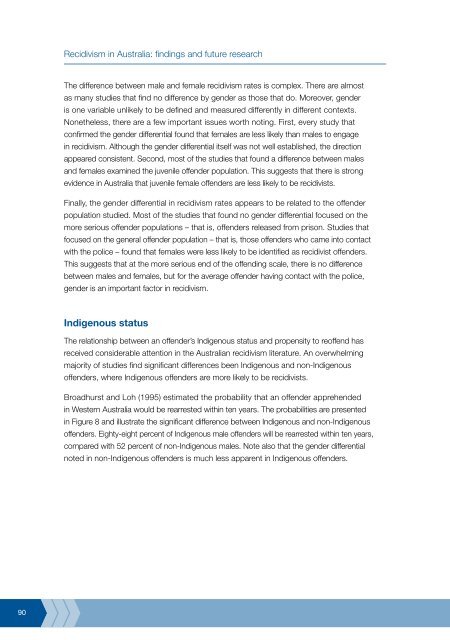Recidivism in Australia : findings and future research - Australian ...
Recidivism in Australia : findings and future research - Australian ...
Recidivism in Australia : findings and future research - Australian ...
Create successful ePaper yourself
Turn your PDF publications into a flip-book with our unique Google optimized e-Paper software.
90<br />
<strong>Recidivism</strong> <strong>in</strong> <strong>Australia</strong>: f<strong>in</strong>d<strong>in</strong>gs <strong>and</strong> <strong>future</strong> <strong>research</strong><br />
The difference between male <strong>and</strong> female recidivism rates is complex. There are almost<br />
as many studies that f<strong>in</strong>d no difference by gender as those that do. Moreover, gender<br />
is one variable unlikely to be def<strong>in</strong>ed <strong>and</strong> measured differently <strong>in</strong> different contexts.<br />
Nonetheless, there are a few important issues worth not<strong>in</strong>g. First, every study that<br />
confirmed the gender differential found that females are less likely than males to engage<br />
<strong>in</strong> recidivism. Although the gender differential itself was not well established, the direction<br />
appeared consistent. Second, most of the studies that found a difference between males<br />
<strong>and</strong> females exam<strong>in</strong>ed the juvenile offender population. This suggests that there is strong<br />
evidence <strong>in</strong> <strong>Australia</strong> that juvenile female offenders are less likely to be recidivists.<br />
F<strong>in</strong>ally, the gender differential <strong>in</strong> recidivism rates appears to be related to the offender<br />
population studied. Most of the studies that found no gender differential focused on the<br />
more serious offender populations – that is, offenders released from prison. Studies that<br />
focused on the general offender population – that is, those offenders who came <strong>in</strong>to contact<br />
with the police – found that females were less likely to be identified as recidivist offenders.<br />
This suggests that at the more serious end of the offend<strong>in</strong>g scale, there is no difference<br />
between males <strong>and</strong> females, but for the average offender hav<strong>in</strong>g contact with the police,<br />
gender is an important factor <strong>in</strong> recidivism.<br />
Indigenous status<br />
The relationship between an offender’s Indigenous status <strong>and</strong> propensity to reoffend has<br />
received considerable attention <strong>in</strong> the <strong>Australia</strong>n recidivism literature. An overwhelm<strong>in</strong>g<br />
majority of studies f<strong>in</strong>d significant differences been Indigenous <strong>and</strong> non-Indigenous<br />
offenders, where Indigenous offenders are more likely to be recidivists.<br />
Broadhurst <strong>and</strong> Loh (1995) estimated the probability that an offender apprehended<br />
<strong>in</strong> Western <strong>Australia</strong> would be rearrested with<strong>in</strong> ten years. The probabilities are presented<br />
<strong>in</strong> Figure 8 <strong>and</strong> illustrate the significant difference between Indigenous <strong>and</strong> non-Indigenous<br />
offenders. Eighty-eight percent of Indigenous male offenders will be rearrested with<strong>in</strong> ten years,<br />
compared with 52 percent of non-Indigenous males. Note also that the gender differential<br />
noted <strong>in</strong> non-Indigenous offenders is much less apparent <strong>in</strong> Indigenous offenders.















